|
Greetings, and welcome to the Winter 2019 edition of FGS News and Research. It has been an eventful winter season at FGS. I was recently honored to join Deputy Secretary John Truitt, State Parks Director Eric Draper, Wakulla Springs State Park Manager Amy Conyers and Florida Representative Loranne Ausley in designating Wakulla Springs State Park as the newest State Geological Site. Wakulla Springs joins Devil’s Millhopper, Florida Caverns and Windley Key state parks in this designation, and there will be more to come in 2019.
In this issue, I invite you to learn about Florida’s index fossils, the geologic wonders of Weeki Wachee Springs State Park, and our Featured Formation - the Jackson Bluff Formation. This issue also provides news of an
FGS core drilling project at a significant vertebrate fossil site in collaboration with the Florida Museum of
Natural History.
I extend a special thank you to those of you who attended our FGS Earth Science Open House in December.
he “Earth as Inspiration” themed event was well-attended and hosted hundreds of citizens of all ages to discover the wonders of Florida geology. FGS staff initiated an #FGSRocks campaign, an interactive “hide and seek” with rocks painted by Open House visitors to illustrate how far rocks can travel before they are found. One painted rock has already been found in New Mexico!
This theme was amplified by the beautiful paintings on display by world-renowned artist Gabrielle Wu Lee, which were generously donated to the FGS by Dr. Paul Z. Lee, husband of the late artist. The newsletter banner above highlights one of Gabrielle Lee’s paintings. Learn more about her incredible work in this issue.
Sincerely,
 Jonathan D. Arthur, Ph.D., P.G.
Director and State Geologist
Florida Geological Survey
Florida Department of Environmental Protection


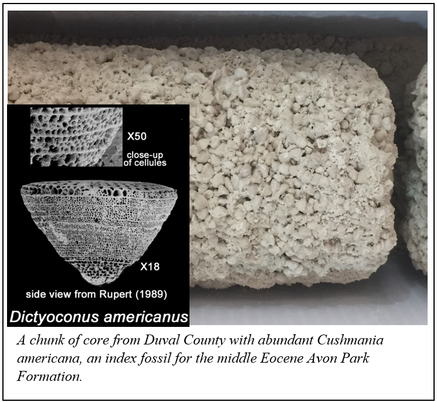
Fossils are the remains of ancient life. Florida contains some of the most abundant and diverse fossil deposits in the world. For instance, the Pinecrest member of the Pliocene Tamiami Formation in South Florida contains one of the most well-preserved and diverse fossil molluscan assemblages in the world, with more than 1,200 species identified. Florida’s geologic history is responsible, in part, for providing the perfect setting for the accumulation and preservation of fossils. Our limestone bedrock includes the remains of countless marine organisms that lived, died, and accumulated on the sea floor. Over millions of years, the remains of those organisms became cemented together to form limestone. Florida is underlain by thousands of feet of limestone, and much of it looks similar. How do geologists identify rocks that look the same but are not the
same age?
One way is to look for index fossils, which identify and date the strata in which they occur. The most useful index fossils come from organisms that evolved rapidly, were distributed widely, were abundant, and lived for a fairly short period of time. Many of the best index fossils are from marine organisms including foraminifera, ammonites and graptolites. However, any fossil that fits the criteria can be used as an index fossil.
|
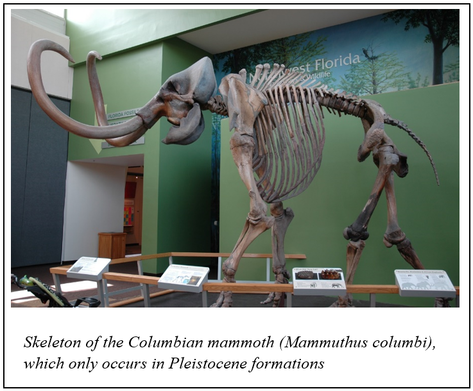
Florida’s geologic strata are subdivided into mappable, definable, discrete layers called formations. Many of these formations were deposited in shallow, nearshore marine environments that have existed for tens of millions of years. Similar depositional environments produce similar sediment and rock types that can be hard to identify without the aid of index fossils. Florida’s oldest formation exposed at the land surface is the Avon Park Formation. It underlies the Ocala Limestone and is similar in many ways. However, the Avon Park Formation contains several index fossils that occur only in that formation. One example is the small, cone-shaped foraminifera Cushmania americana. When a geologist encounters one of these index fossils, it means that the rocks are middle Eocene in age. The Avon Park Formation was deposited during the middle Eocene and is the only geologic formation of that age known in peninsular Florida. The overlying Ocala Limestone does not contain these cone-shaped foraminifera, so when the fossil is encountered you know the age of the formation.
There are index fossils contained in most of Florida’s geologic formations. Some other examples include the sea biscuit Rhyncholampas gouldii found in the early Oligocene Suwannee Limestone, the bivalve mollusk Amusium ocalanum found in the late Eocene Ocala Limestone, and even the remains of the Columbian mammoth (Mammuthus columbi), which, when found in geologic context, indicates Pleistocene age.
Contact:
Harley Means, P.G. Administrator
Back to top
|

Geologic formations are the basic rock units used in stratigraphy, the branch of geology focusing on layers of sediments and sedimentary rocks (strata) that have accumulated over geologic time.
In their 1964 publication, FGS geologists Harbans Puri and Robert Vernon combined two strata rich in fossil mollusks (the Ecphora and Cancellaria faunal zones) and named the new unit the Jackson Bluff Formation. The stratigraphic unit is named after Jackson Bluff, an erosional scarp located on the east bank of the Ochlocknee River in western Leon County. At that time, Jackson Bluff was the only place known where both faunal zones were exposed. A small barrow-pit located near the bluff is designated as the type section for the Jackson Bluff Formation.
|

Early geologists like Puri and Vernon working in Florida recognized that some strata contained recognizable fossil assemblages and they used these assemblages, to identify formations. Although fossils are important in identifying the age and depositional environments in which sedimentary rocks form, it is the lithology that defines formations. The Jackson Bluff Formation’s lithology consists of greenish to dark gray, fossiliferous, clayey sand to sandy clay that may contain minor amounts of phosphate and heavy minerals. The formation is primarily a subsurface unit and is exposed only along rivers and streams from Leon County west into western Bay and eastern Washington counties.
|
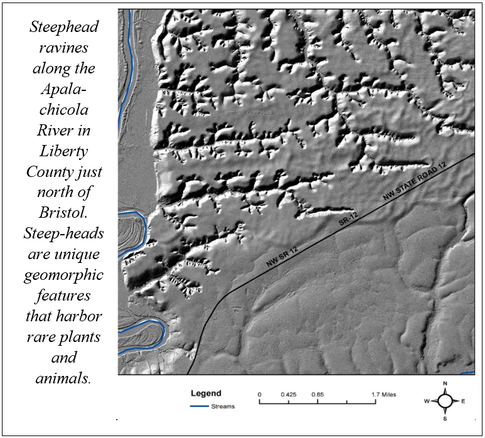
The fossil assemblage contained within the Jackson Bluff Formation has been well documented. The Jackson Bluff Formation contains more than 200 species of mollusks as well as corals, echinoderms (sand dollars), foraminifera and marine vertebrates like sharks and whales. The fossils are of marine origin and reflect the shallow, cool-water environments that existed in estuaries and nearshore environments during the late Pliocene Epoch (3.6 to 2.58 million years ago) in northern Florida when sea level was higher than today.
The Jackson Bluff Formation underlies the Citronelle and Miccosukee formations in the Florida Panhandle and overlies the Torreya Formation, Chipola Formation and other Alum Bluff Group formations west of the Apalachicola River. Where it underlies the sand and gravel deposits within the Citronelle Formation, the Jackson Bluff Formation acts as a barrier to the downward percolation of groundwater and is partly responsible for the development of geomorphic features called steepheads. Steepheads, as the name implies, are steep-sided ravines formed by headward erosion as groundwater flows laterally between the underlying clayey Jackson Bluff Formation and the overlying sand and gravel. Groundwater emerges from the base of semi-circular shaped escarpments at the head of each steephead ravine.
Contact: Harley Means, P.G. Administrator
|

Every day, eager guests of Weeki Wachee Springs State Park enjoy the geologic wonderment as they watch the park’s famous mermaids, take a scenic river boat tour, or splash with energy and excitement in the clear water emitted from the park’s namesake spring. The water originates from limestones of the Floridan aquifer system, one of the world’s most productive aquifers, spanning that spans across Florida and parts of neighboring states. Over 100 million gallons of groundwater flow out of this first magnitude spring each day. That is roughly equal to 150 Olympic-size swimming pools filled each day.
Rocks belonging to the Suwannee Limestone are exposed along the edges of the spring pool above water, prominently in the spring, and along the Weeki Wachee River. The Suwannee Limestone is a tan to light brown fossiliferous limestone deposited between 34 to 28 million years ago in the warm marine waters of the early Oligocene Epoch. Dolostone may also be present and is a form of limestone that has been altered by magnesium-rich water. The limestones are formed into rock over geologic time by the slow lithification of the many accumulated layers of fossil remains from sand dollars, sea biscuits, clams, snails, single-celled organisms called foraminifera, and algae, all made of calcium-carbonate.
|

Calcium-carbonate can be slowly dissolved by water, which is naturally weakly acidic. This slow dissolution of limestone creates and enlarges pores in the rock, resulting in a sponge-like appearance. Water in the aquifer flows through those pores. The continued enlargement and eventual connection of those pores creates conduits, which can be large enough for divers to swim through, such as the large conduit cave system explored by divers at Weeki Wachee Spring. Cave divers have explored the spring’s system of conduits to over 400 feet below land surface.
The process of dissolving limestone results in a special topographic landscape called karst. Karst topography is defined by the presence of springs, sinkholes, caves, and disappearing and reappearing streams, all of which are found near Weeki Wachee Springs State Park.
Contact: Clint Kromhout, P.G. Administrator
|
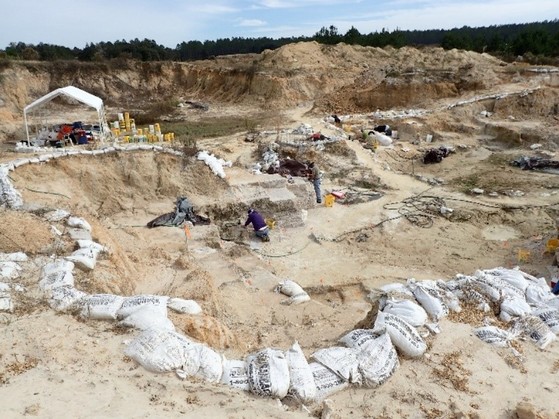
The Florida Geological Survey (FGS) received a request in May 2018 from the Florida Museum of Natural History in Gainesville to drill new cores at a significant vertebrate fossil dig site. According to Dr. Jonathan Bloch, Curator of Vertebrate Paleontology for the museum, this site represents “a once-in-a-decade discovery in regards to the quality and abundance of vertebrate fossils and is the only source of late [Hemphillian] (latest Miocene-early Pliocene) vertebrate fossils in northern Florida.”
The site has been excavated by a team of nearly 700 volunteers since its discovery in 2015, and they have yet to define the extent of the deposit. Dr. Bloch’s team hopes that information from the new cores will aid in reconstructing a geologic history of the area that preserved such a rich assemblage of fossils and help paleontologists determine the extent of the deposit so a plan for future expansion of the dig can be made.
|

To the extent possible, the cores will capture a complete vertical section of the fossil-rich sediments. The drill crew will core through the fossiliferous sediment and into the underlying Ocala Limestone, providing valuable top-of-rock data that is critical to improving geologists’ understanding of the Floridan Aquifer System. One core will be drilled to the top of the Avon Park Formation, which underlies the Ocala Limestone, filling a gap in geologic data from this region and supporting geologic framework and hydrogeologic studies.
The cores will be studied by University of Florida graduate student Michael Ziegler who will use the cores as part of his Master of Science thesis in geology. Ziegler will correlate the sediments from the cores to the sediments observed in the walls of the excavation, further refining both the extent and the environment responsible for creating this unique fossil deposit.
The cores will be archived at the FGS Core & Cuttings Repository in Tallahassee.
Contact: David Paul, P.G. Administrator
|
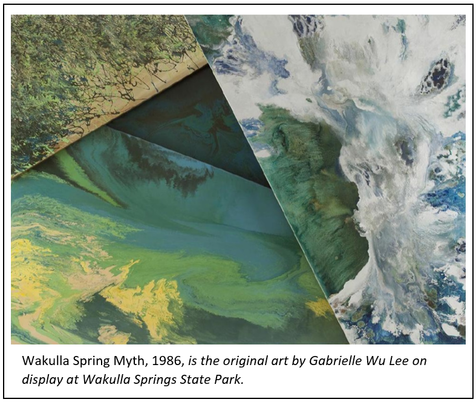
The FGS Earth Science Week Open House (delayed from October to December 2018 due to Hurricane Michael) had a strong art component for the first time in FGS history. A writing and art contest for grades 6-9 increased local student involvement as contestants answered the question, “How Does the Earth Inspire You?” and visitors painted rocks for the new #FGSRocks campaign.
Geoscience learning stations, contests and rock painting were not the only artistic component at the geology open house, which received more than 200 visitors. Paintings by world-renowned artist Gabrielle Wu Lee brightened the walls at FGS headquarters in Tallahassee, amplifying and bringing the theme of “Earth as Inspiration” to colorful life. Two paintings were generously donated to the FGS in November by Dr. Paul Lee, husband of the late artist who passed away in December 2010.
Gabrielle Wu Lee’s Carlsbad Tempo, Southwest Travel Log Series, 1984, enamel on canvas, 48 x 80 inches can be viewed in the conference room at 3000 Commonwealth Blvd. Dr. Paul Lee eloquently describes this exceptional piece: “The deep (750 feet from the land surface) and very large and complex Carlsbad Cavern leads us to another world in the heart of the earth. Unexpected scenes at every turn surprise visitors throughout the long and sometimes steep walking passages in the cavern. Exploring the space is like getting to know a new friend or a new civilization.” In the FGS Walter Schmidt Museum, the second painting donated by Dr. Paul Lee is on display – Wakulla Spring Myth Study No. 12, Deep Current, 1985, oil on canvas, 36 x 72 inches.
Later during the month, another of Gabrielle Wu Lee’s masterworks was donated to the Edward Ball Wakulla Spring State Park as part of the State Geologic Site designation ceremony led by State Geologist Dr. Jon Arthur. The painting, Wakulla Spring Myth, 1986, oil on canvas, 72 x 96 inches (four-layer relief), is proudly on display at the Wakulla Springs lodge. In Dr. Paul Lee’s words:
Wakulla Springs is the crown jewel of Florida. A crystal clear, mirror-like pool on top of the Springs reflects the passing clouds and the blue sky. Water plants bow and wave within the rapid flow of water. Alligators and waterfowl make their homes in the river on its unique islands of cypress knees and floating water-plants. The limestone formation has been leached white, visible through the 190-foot depth of spring water. The eye of the springs gazes up from underneath the water surface. All around the forest, the wildlife, and the crystal-clear rushing spring looks just like the original Garden of Eden.
Gabrielle Reng-Yi Wu Lee, MD, MFA, was born in Shanghai, China, where she studied medicine and practiced as a doctor of internal medicine. She moved to the United States with her husband, Paul Zi-Fang Lee, to pursue her graduate studies at FSU. She won a prestigious University Fellowship and earned her MFA from FSU in 1986. She became a professional artist, creating large-scale oil paintings based on her innovative philosophy, aesthetics, techniques and style that she coined Dynamic Expressionism. She exhibited her work in dozens of exhibits and public art institutions, winning numerous awards. Her work was recognized worldwide, and she was invited six times to the renowned International Biannual Contemporary Art Exhibition in Florence, Italy.
Gabrielle Wu Lee’s work in Dynamic Expressionism can now be enjoyed at the FGS, Wakulla Springs State Park and online. Gabrielle Wu Lee’s art reflects the powerful impact that nature has on humanity, which is why Dr. Paul Lee proudly refers to his late wife’s work as “inspired by nature.”
Human beings, as part of nature, are nurtured and fed by nature, surviving in nature, learning from nature, interacting with nature, inspired by nature to form, accumulate and refine our understanding of our environment, our self-cognition, our body, our society, our culture, knowledge, skill, technology and creativity. Such inspirations affect all aspects of our civilization, directly or indirectly. We, you and me, are Inspired by Nature, day-in day-out, on pursuing Truth, Justice, Righteousness and Beauty; for a more productive and creative life, as well as for a more loving, efficient, beautiful, prosperous, harmonious, sustainable and safer society. - Paul Lee, Ph.D., 2018, for Open House at the Florida Geological Survey
Contact: Sarah Erb, Operations Management Consultant
|
|